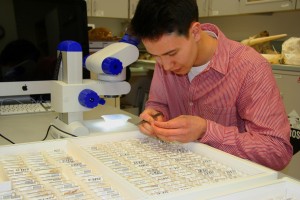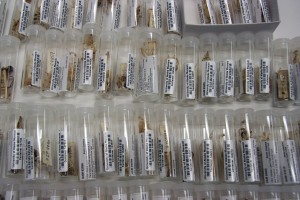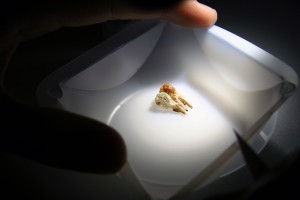Museum research leads high school student to nationals
May 2, 2013
907-474-6941
5/2/13

A Fairbanks high school student is headed to the National Junior Science and Humanities Symposium in Ohio this month with a research project on the effects of climate change on Alaska’s shrews.
For this year’s Alaska Statewide High School Science Symposium, Lathrop High School senior Kelly May repeated a study published in 2005 using masked shrew specimens housed at the University of Alaska Museum of the North. May's work refutes the results of that study, which concluded that shrews in Alaska are getting larger over recent periods. The original study was based entirely on external measurement data downloaded from the museum’s online database. The authors were not able to inspect each specimen.
May believed that not accounting for age in the original research may have biased the results.
“The exciting physical part of my research was finding each of the 650 shrews in the collection and looking at their teeth to determine age,” May said.
Each shrew species has a unique tooth pattern. Since Alaska’s shrews can be difficult to identify, May first confirmed the specimens were the correct species, Sorex cinereus. Determining the age involved looking at the degree of wear on their teeth. Shrews do not hibernate and are active year round but they rarely live more than 15 months. Adults that survive a winter show significant tooth wear, while shrews born in the spring do not.

Last year, May’s ASHSSS project showed that young shrews are significantly smaller than overwintered adults and that overwintered females are bigger than overwintered males. In contrast to previously published claims, this means that age and sex both need to be accounted for in studies of body size in shrews, according to the museum's curator of mammals, Link Olson.
“A recent study concluded that a common shrew species found throughout most of Alaska increased in size over the past half century, possibly in response to climate change: Longer summers and warmer winters result in greater food availability,” he said. “However, this study did not account for sex or age and concluded that individual shrews are attaining a larger body size.”
By analyzing juvenile and adult specimens separately and accounting for sex, May found that individual shrews are actually getting smaller but that more are surviving the winter, meaning that the proportion of larger-bodied adults in a given population is increasing. So although the two studies reached seemingly similar conclusions, May’s results shed new light on the underlying mechanism: shrews aren’t growing to a larger body size, they’re just surviving winters better.

Olson said May's project has implications for studying how mammals are responding to climate change, an important justification for students to have access to the museum’s collections.
“Seeing and using museum collections makes scientific inquiry and discovery tangible and can be intellectually empowering to students,” he said. “Today's students are tomorrow's scientists. Middle school and high school students now have access to hands-on research opportunities my generation didn't until college or later. This is a positive trend.”
In June, May will travel to Philadelphia to present his research at the annual meeting of the American Society of Mammalogists, where he will be the youngest and only high school student to present. May plans to attend UAF in the fall.
ADDITIONAL CONTACTS: Link Olson, UAMN curator of mammals, at 907-474-5998 or link.olson@alaska.edu.
ON THE WEB:
NOTE TO EDITORS: Photos are available for download at www.uafcornerstone.net/UAMNshrews
TB/5-2-13/277-13


